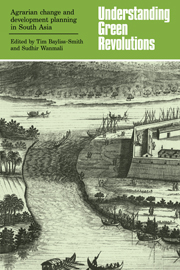Book contents
- Frontmatter
- Contents
- List of contributors
- Preface
- I Understanding Green Revolutions: an overview
- II Agrarian change at village level
- 5 Agrarian policy and agrarian change in tribal India
- 6 Migration and agrarian change in Garhwal District, Uttar Pradesh
- 7 Agricultural development in Tamil Nadu: two decades of land use change at village level
- 8 Energy flows and agrarian change in Karnataka: the Green Revolution at micro-scale
- 9 Income and wealth disparities in a land settlement of the Sri Lanka Dry Zone
- 10 Agrarian structure and agricultural innovation in Bangladesh: Panimara village, Dhaka district
- 11 A structural analysis of two farms in Bangladesh
- III Development planning and agrarian change
- Index
10 - Agrarian structure and agricultural innovation in Bangladesh: Panimara village, Dhaka district
Published online by Cambridge University Press: 25 May 2010
- Frontmatter
- Contents
- List of contributors
- Preface
- I Understanding Green Revolutions: an overview
- II Agrarian change at village level
- 5 Agrarian policy and agrarian change in tribal India
- 6 Migration and agrarian change in Garhwal District, Uttar Pradesh
- 7 Agricultural development in Tamil Nadu: two decades of land use change at village level
- 8 Energy flows and agrarian change in Karnataka: the Green Revolution at micro-scale
- 9 Income and wealth disparities in a land settlement of the Sri Lanka Dry Zone
- 10 Agrarian structure and agricultural innovation in Bangladesh: Panimara village, Dhaka district
- 11 A structural analysis of two farms in Bangladesh
- III Development planning and agrarian change
- Index
Summary
Over the past twenty years successive governments in what is now Bangladesh have made major efforts to increase agricultural production through the introduction of high-yielding varieties of paddy (HYVs), fertilisers, pesticides and modern irrigation technology such as low-lift pumps, which take water from rivers and creeks, and deep and shallow tubewells (Hossain & Jones, 1983). Between 1960 and 1980 the area irrigated by modern methods increased from zero to nearly 0.9 million hectares out of a net cropped area of 9 million hectares. The use of chemical fertilisers increased from nothing to over 100 kg per net cropped hectare, and the area under HYVs developed at the International Rice Research Institute (IRRI) and the Bangladesh Rice Research Institute (BRRI) reached over 20% of the total area under foodgrains. Foodgrain production which in the late 1950s averaged 8 million tonnes increased to 13 million tonnes by the late 1970s. Much of the increase was due to the cultivation of IR-8 and BR-3 under irrigation in the dry (bow or rabi) season, though the cultivation of the same varieties later on as an early monsoon (aus or early kharif season) crop, and other varieties such as IR-20 and BR-4 in the late monsoon (aman or late kharif), was also important. In parts of the country, especially in the north and west, wheat cultivation has also increased rapidly since 1975.
Despite the significant success achieved in increasing agricultural production, however, Bangladesh paddy yields and input use are still amongst the lowest in Asia (Jones, 1979). Much more could be done. If full irrigation potential were realised food production could be doubled or trebled.
- Type
- Chapter
- Information
- Understanding Green RevolutionsAgrarian Change and Development Planning in South Asia, pp. 194 - 211Publisher: Cambridge University PressPrint publication year: 1984
- 2
- Cited by



